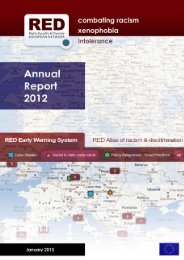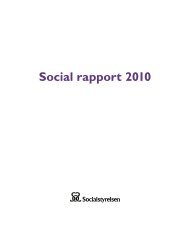R6PITFALLS AND BIASREGIONAL TRENDS IN SPECIAL EDUCATION ENROLLMENT RATESThe countries that are <strong>the</strong> subject <strong>of</strong> <strong>the</strong> case studies in this document have much higher rates <strong>of</strong> segregating pupilsin special schools than <strong>the</strong>ir European counterparts like Finl<strong>and</strong>, France, Italy, or <strong>the</strong> United Kingdom, none <strong>of</strong>which categorize special educational needs in legislation. For example, Italy has by far <strong>the</strong> lowest rate <strong>of</strong> segregation,with only 693 pupils in segregated institutions out <strong>of</strong> a total special educational needs population <strong>of</strong> 170,696, while<strong>the</strong> United Kingdom <strong>and</strong> Italy have remained <strong>the</strong> most consistent with low segregation rates between 2001 <strong>and</strong> 2008,at 1.1 percent <strong>and</strong> 0.5 percent or less, respectively. Both France <strong>and</strong> Finl<strong>and</strong>’s rates <strong>of</strong> segregating pupils in specialschools have decreased in <strong>the</strong> same period, as has <strong>the</strong> percentage <strong>of</strong> pupils labeled with special educational needs.In <strong>the</strong> Czech Republic, Hungary, <strong>and</strong> Slovakia, <strong>the</strong> percentage <strong>of</strong> pupils segregated in special schools (includingthose relabeled “practical schools” in <strong>the</strong> Czech Republic) remains well above <strong>the</strong> European average <strong>of</strong> two percent.In <strong>the</strong> Czech Republic, <strong>the</strong> percentage <strong>of</strong> children with special educational needs has dropped, from 9.8 percentto 8.6 percent, as has <strong>the</strong> percentage <strong>of</strong> pupils segregated in special schools, from five percent to 3.5 percent.In Hungary <strong>and</strong> Slovakia, on <strong>the</strong> o<strong>the</strong>r h<strong>and</strong>, <strong>the</strong> rate <strong>of</strong> identification <strong>of</strong> pupils with special needs has actually increased,from 4.1 percent to 5.8 in Hungary <strong>and</strong> from four percent to 7.7 percent in Slovakia. The rate <strong>of</strong> segregation inspecial schools is somewhat stable in Slovakia, 3.4 percent in 2001 <strong>and</strong> 3.6 percent in 2008, while <strong>the</strong> data availablefor this period do not point to a clear trend in <strong>the</strong> rate <strong>of</strong> segregation in special schools in Hungary.TABLE S1. Classification <strong>and</strong> segregation <strong>of</strong> pupils with special educational needsPercentage <strong>of</strong> all pupils Percentage <strong>of</strong> all pupils in segregatedwith specialspecial education institutionseducational needsYear 2001 2008 2001 2002–2004 2008Czech Republic 9.8 8.6 5.0 5.0 3.5Finl<strong>and</strong> 17.8 8.0 3.7 3.6 1.3France 3.1 2.7 2.6 2.2 0.61Hungary 4.1 5.8 3.7 3.9 2.9Italy 1.5 2.3
R7For <strong>Romani</strong> children in Central <strong>and</strong> Eastern Europe, a disability label generally serves to segregate <strong>the</strong>m <strong>and</strong> provide<strong>the</strong>m with an inferior education under <strong>the</strong> law through streaming into special education on <strong>the</strong> basis <strong>of</strong> testingprior to or in <strong>the</strong> first years <strong>of</strong> primary education. As is true throughout <strong>the</strong> region, Roma are disproportionatelypresent in special education in <strong>the</strong> case study countries, accounting for a majority <strong>of</strong> pupils in practical schools in<strong>the</strong> Czech Republic; between 20 <strong>and</strong> 90 percent <strong>of</strong> children in special education in Hungary; 25–40 percent <strong>of</strong>pupils in special primary schools <strong>and</strong> 40 percent <strong>of</strong> students in special secondary schools in Serbia; <strong>and</strong> approximately60 percent <strong>of</strong> children in special primary <strong>and</strong> secondary education in Slovakia. Pupils from <strong>Romani</strong> communitiesthus tend to have experiences in educational milieus in which teachers have lowered expectations <strong>of</strong> <strong>the</strong>m,presume <strong>the</strong>m to be academically <strong>and</strong> socially deficient, <strong>and</strong> blame <strong>the</strong>m for <strong>the</strong>ir failure to succeed in schools.This failure in schools is based almost entirely on <strong>Romani</strong> children’s placement in special education, wherereassignment to st<strong>and</strong>ard education is rare <strong>and</strong> <strong>the</strong>re is limited opportunity for secondary education, negativelyaffecting <strong>the</strong>ir later participation in <strong>the</strong> labor market <strong>and</strong> entrapment by poverty to complete a vicious circle <strong>of</strong>special education, school failure, unemployment, <strong>and</strong> poverty.METHODOLOGICAL PITFALLS AND BIAS IN ENTRY TESTINGAmong <strong>the</strong> roots <strong>of</strong> <strong>the</strong> broader problem <strong>of</strong> separating children into educational streams are two major methodologicalflaws in entry testing as practiced in <strong>the</strong> Czech Republic, Hungary, Serbia, <strong>and</strong> Slovakia. First, only one kind<strong>of</strong> instrument is used. Second, <strong>the</strong> instruments rely on st<strong>and</strong>ardized measures that assume a pupil’s exposure tocertain cultural experiences resulting in a repertoire <strong>of</strong> knowledge <strong>and</strong> skills associated with putatively intelligentbehavior, as well as a vocabulary associated with membership in <strong>the</strong> middle class. All <strong>of</strong> <strong>the</strong>se countries relyheavily on at least one <strong>of</strong> two culturally <strong>and</strong> linguistically biased tests commonly used to make disability determinations(<strong>the</strong> Raven’s Progressive Matrices <strong>and</strong> <strong>the</strong> Wechsler Intelligence Scale for Children).Raven’s Progressive MatricesFirst published in 1938, <strong>and</strong> used frequently today in Hungary, Serbia, <strong>and</strong> Slovakia (as well as in many o<strong>the</strong>r countries),Raven’s Progressive Matrices are nonverbal assessments purported to be free <strong>of</strong> or to have reduced cultural bias.In <strong>the</strong>se tests, “correct” responses are those which complete an abstract pattern <strong>of</strong> matrices in <strong>the</strong> most putativelyobvious way. If respondents take a more creative approach to <strong>the</strong> patterns, however, <strong>the</strong> resulting responsesare likely to affect test (that is, IQ) scores negatively. Moreover, <strong>the</strong> fact that performance improves with repeatedadministrations <strong>of</strong> <strong>the</strong> test to members <strong>of</strong> non-dominant cultural communities suggests that <strong>the</strong> ProgressiveMatrices are in fact not free <strong>of</strong> cultural bias. In similar fashion, children trained in inductive reasoning strategiestend to perform better on <strong>the</strong> test than do children who do not receive such training. Finally, changing testingconditions by presenting instructions in different ways has been shown to impact <strong>the</strong> performance <strong>of</strong> children fromlower socio-economic strata, with such children performing better when <strong>the</strong> test is presented as a game thanwhen it is presented as an evaluation <strong>of</strong> strengths <strong>and</strong> weaknesses.
- Page 3 and 4: R3CONTENTSACKNOWLEDGMENTS 4EXECUTIV
- Page 5: R5EXECUTIVE SUMMARYThis policy pape
- Page 10 and 11: R10PITFALLS AND BIAS4. Discontinue
- Page 12 and 13: R12PITFALLS AND BIASINTRODUCTIONThe
- Page 14 and 15: R14PITFALLS AND BIASa child is read
- Page 16 and 17: R16PITFALLS AND BIASthe child (Ryan
- Page 18 and 19: R18PITFALLS AND BIASTABLE 2. Placem
- Page 20 and 21: R20PITFALLS AND BIASAMONG THE ROOTS
- Page 22 and 23: R22PITFALLS AND BIASTAXONOMY OF “
- Page 24 and 25: R24PITFALLS AND BIASdevelop the ver
- Page 26 and 27: R26PITFALLS AND BIAS2008, 136). Ard
- Page 28 and 29: R28PITFALLS AND BIASBias in test ad
- Page 30 and 31: R30PITFALLS AND BIASWhile the test
- Page 32 and 33: R32PITFALLS AND BIASOF ROMANI CHILD
- Page 34 and 35: R34PITFALLS AND BIAStwo distinct ty
- Page 36 and 37: R36PITFALLS AND BIASPOLICY AND PRAC
- Page 38 and 39: R38PITFALLS AND BIASand had to repe
- Page 40 and 41: R40PITFALLS AND BIASOrientation Tes
- Page 42 and 43: R42PITFALLS AND BIASTABLE 5. Educat
- Page 44 and 45: R44PITFALLS AND BIASCOUNTRY-SPECIFI
- Page 46 and 47: R46PITFALLS AND BIASPLACEMENT IN SP
- Page 48 and 49: R48PITFALLS AND BIASCompulsory scho
- Page 50 and 51: R50PITFALLS AND BIASand Educational
- Page 52 and 53: R52PITFALLS AND BIAS121.1.cc.ii). A
- Page 54 and 55: R54PITFALLS AND BIASTest of School
- Page 56 and 57:
R56PITFALLS AND BIASof the overall
- Page 58 and 59:
R58PITFALLS AND BIASAS WITH OTHER C
- Page 60 and 61:
R60PITFALLS AND BIASfirst grade, or
- Page 62 and 63:
R62PITFALLS AND BIASbases listed in
- Page 64 and 65:
R64PITFALLS AND BIASof Societies in
- Page 66 and 67:
R66PITFALLS AND BIASTABLE 13. Pupil
- Page 68 and 69:
R68PITFALLS AND BIASROMANI CHILDREN
- Page 70 and 71:
R70PITFALLS AND BIASdetermined to c
- Page 72 and 73:
R72PITFALLS AND BIASdeveloped in th
- Page 74 and 75:
R74PITFALLS AND BIASWechsler Intell
- Page 76 and 77:
R76PITFALLS AND BIAStheir chances t
- Page 78 and 79:
R78PITFALLS AND BIASREPRESENTATION
- Page 80 and 81:
R80PITFALLS AND BIASTABLE 20.Enroll
- Page 82 and 83:
R82PITFALLS AND BIAS
- Page 84 and 85:
R84PITFALLS AND BIASGOOD PRACTICE A
- Page 86 and 87:
R86PITFALLS AND BIASStudent assessm
- Page 88 and 89:
R88PITFALLS AND BIASThe United King
- Page 90 and 91:
R90PITFALLS AND BIASor assistance i
- Page 92 and 93:
R92PITFALLS AND BIASTeachers report
- Page 94 and 95:
R94PITFALLS AND BIASTHE DETERMINATI
- Page 96 and 97:
R96PITFALLS AND BIASintellectual di
- Page 98 and 99:
R98PITFALLS AND BIAS8. Ensure that
- Page 100 and 101:
R100PITFALLS AND BIASANNEX 1:RELIAB
- Page 102 and 103:
R102PITFALLS AND BIAS1. Does the te
- Page 104 and 105:
R104PITFALLS AND BIASANNEX 2:COMPON
- Page 106 and 107:
R106PITFALLS AND BIASFIGURE A4. Sam
- Page 108 and 109:
R108PITFALLS AND BIASAshton-Warner,
- Page 110 and 111:
R110PITFALLS AND BIASCahn, Claude,
- Page 112 and 113:
R112PITFALLS AND BIASD.H. and Other
- Page 114 and 115:
R114PITFALLS AND BIASFigueroa, Rich
- Page 116 and 117:
R116PITFALLS AND BIASGovernment of
- Page 118 and 119:
R118PITFALLS AND BIASHayman, Robert
- Page 120 and 121:
R120PITFALLS AND BIASKovács-Cerovi
- Page 122 and 123:
R122PITFALLS AND BIASMacura-Milovan
- Page 124 and 125:
R124PITFALLS AND BIASMoore, Tom. 20
- Page 126 and 127:
R126PITFALLS AND BIASRadivojevic, D
- Page 128 and 129:
R128PITFALLS AND BIASShepard, Lorri
- Page 130 and 131:
R130PITFALLS AND BIASTomatová, Jan
- Page 132 and 133:
R132PITFALLS AND BIASVláda Česká
- Page 134:
Copyright © 2012 Roma Education Fu




